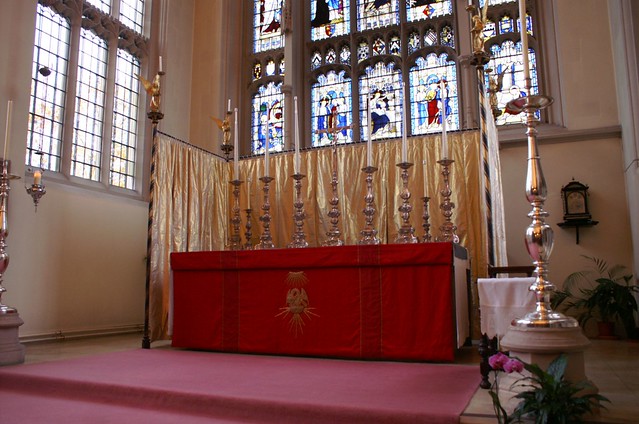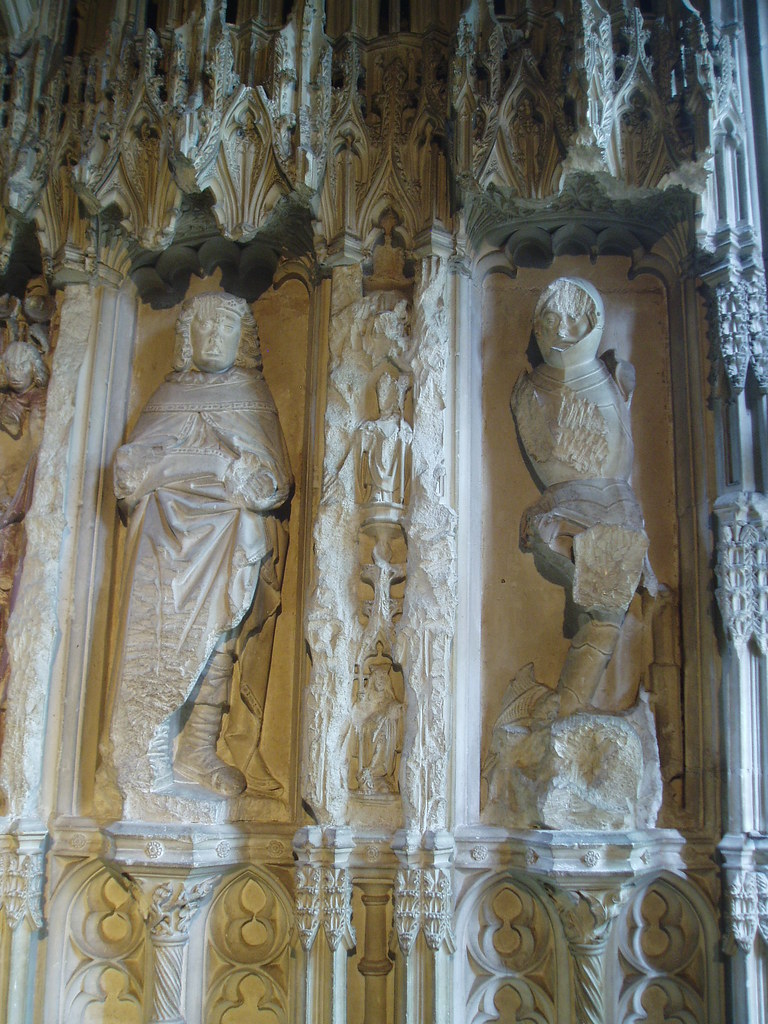Today is the feast of St Louis, who as King Louis IX ruled France from 1226 until his death in 1270, and whose piety led to his canonisation in the reign of his grandson King Philip IV. Thereafter he became the ideal King of France, a role model for his successors and descendants to seek to emulate.
My previous posts about him can be seen at
St Louis, from 2010, and which has alink to a translation of the Sieur de Joinville's delightful biography of his royal master, and also at
Commemorating St Louis from 2012. There is an illustrated online biography of the royal saint here. The illustrations include one of surviving relics of him, such as his shirt which can be seen in Notre Dame in Paris.
A statue of St Louis in the lower chapel of the Sainte-Chapelle in Paris, a building he commissioned
Image:Wikipedia
The illuminated and illustrated Bible of St Louis, preserved at Toledo cathedral, with a few folios, detached in the later middle ages, and including the concluding miniature of the King and his mother Queen Blanche, are now in the Morgan Library and Museum (formerly the Pierpoint Morgan Library) in New York, is one of the great artistic products of its age, and a very substantial link to the King's upbringing and formation. There are more detailed online accounts of it
here and, from the publishers of a facsimile commissioned by the Chapter of Toledo in 1999,
here.
Queen Blanche and King Louis IX, with two scribes below
From the Morgan fragment
Image: Wikipedia
I have adapted part of the account written by the publishers of the facsimile as follows:
The first documented record concerning the Bible of St Louis appears in the will and testament of King Alfonso X the Wise of Castile. This will, written in 1282, describes a Bible "of three illuminated volumes given to us by King Louis of France." This short but precise description is sufficient to lead us to believe that he was referring to the same copy that resides today in the treasury of Toledo Cathedral. In addition, this particular copy, divided into three books or volumes each replete with ornate illustrations of the biblical tales and originally owned by King Louis IX of France is surprisingly similar to the Rich Bible of Toledo. Furthermore, the will explains that King Louis IX gave the codex to King Alfonso X as a gift. This valuable piece of evidence clarifies the mystery surrounding the presence of this bibliographic gem in Castile.
In his will, King Alfonso X expressed great appreciation for this Bible classifying it as one of the "noblest possessions belonging to the King." In his testament of 1284, he also alludes to the Bible as one of "the things we had in Toledo that were taken" during a robbery of the royal possessions in the revolt gainst him by his son Sancho. The king describes his regret at having lost one of "the rich and noble things that belonged to the kings". This entry, in addition to the similar phrase written in his will, attests to the fact that this invaluable piece of art was destined for the exclusive use of royalty.
The Bible of St Louis is one of a small group of Bibles copied in the 13th century for members of the French royalty belonging to the Capetian dynasty ruling at that time. It is a peculiar type of biblical book without precedents in the tradition of European scriptoria, and is lavishly illuminated in keeping with the rank of its owners.
These bibles were usually known by the more modern name of Bibles moralisées and were few in number, as mentioned earlier, due to the high cost of producing them. The most obvious feature of these books is their incredible lavishness and splendour. Their external appearance is so exceptional that one immediately realises that their owners could only be the most high-ranking persons in medieval society. This was indeed the case: these Bibles were made for the use of kings alone.
The huge number and quality of their illuminated storia catch the reader's attention from the start. The singularity of these Bibles is demonstrated mainly in two aspects: their codicology and texts.
From the viewpoint of the work as a book, we must admit that everything in it is extraordinary. The persons who commissioned it envisaged a project on a vast scale, far larger than any usually produced by book craftsmen. We could even say that everything was sacrificed in the name of magnificence. Some of the requirements in terms of grandeur and splendour imposed by the project forced those working on it to breach many of the rules laid down in the ateliers of copyists and illuminators.
Whilst not of the same size as the ancient Atlantic Bibles, it has nevertheless a very large format and an exceptional number of folios, all of the finest quality. The enormous amount of decoration made it impossible for the parchment folios to bear so much paint and gold on both sides since the pigments would have soaked through to the other side, causing the sheets to crumple. The only solution was to leave one side of each folio blank.
The most surprising aspect is that the sides used for the text and images were not the flesh sides, which are whiter, but the hair sides. The reason for this was that the roughness of the hair side enabled the pigments to adhere much better.
The entire Bible is presented as a totum continuum, opening with a large, illuminated page (God, the Creator of the Universe) and ending with a full-page miniature (Queen Blanche and her son Louis at the top and the codex craftsmen at the bottom), an indication that the book was designed as a single unit. The completed quires were gradually accumulated and in the end it was necessary to split the work into three volumes: a final operation which was not envisaged or allowed for originally. The division was done in a rather arbitrary fashion as revealed by the places where the work was divided into volumes.
Looking at the work from the viewpoint of its texts, it can be seen that this book does not coincide completely with our notion of what a Bible is.
A page from the Bible
Image: omifacsimiles.com
First of all a careful analysis of the text shows that it is not a complete Bible but a selection of biblical texts, with many others missing. Exactly half of the text does not belong to the Bible but consists of commentaries written by anonymous theologians. No biblical text stands alone: each one is accompanied by an authorised commentary. These short theological texts were so important to those in charge of the work that they were given the same treatment as the biblical texts themselves: both types of texts were glossed iconographically by an illuminated storia along the side.
Hence the texts in this work belong to both the Bible and theology in equal parts. The foregoing also demonstrates that, in this respect too, the Bible of St Louis is a very particular Bible, an utterly singular work.
King
Alfonso X wrote in his testament that the work was made for use of kings, but the crucial question remains, why did the King of France and his mother need it? Was it just a whimsical possession? There is no documentation in the royal records of France about the purpose for which the Bible was made. However, we cannot reject the theory that the Bible had some utilitarian purpose for the people who used it in the Middle Ages. Books were made to be used as a vehicle of learning and information. According to this theory, books circulated amongst the people who had a use for it. The fact that the Bible was made during the time that the French prince was in his
school years suggests that it was made to serve as a pedagogical instrument to complement the education of the future monarch of France. One might even venture to say that it was given to King Alfonso X the Wise in order to educate his children and grandchildren.
From the last illuminated folio, we can determine the timeframe in which the codex was copied and illuminated. King Louis IX of France was born in 1214 and came to the throne in 1226. In 1234 he married Margaret, the daughter of Ramon Berenguer IV, Count of Provence. Given that Saint Louis appears in the portrait as the reigning king but is still unwed, we can deduce that the Bible was completed between 1226 and 1234.
The Creator of the Universe
From the beginning of the Bible of St Louis
Image:Wikipedia
To that I would add that the fact that the young King imbibed his faith well is well attested by his life and deeds, and his subsequent canonisation. His sense of calling and Christian duty can be seen in the text of St Louis' spiritual testament to his son, the future King Philip III, which is appointed for the Office of Readings for today:
"My dear son, in the first place I teach you that you must love the Lord, your God, with all your heart and all your strength; unless you do so you cannot be saved. You must guard yourself from everything that you know is displeasing to God, that is to say, from all mortal sin. You must be ready to undergo every kind of martyrdom rather than commit one mortal sin.
If God sends you tribulation, you ought to endure it, giving thanks, realising that it is for your good, and that, perhaps, you have deserved it. If however the Lord confers some benefit on you, you must humbly thank him, and be on your guard not to become the worse for it, either through vainglory or in any other way. You must not offend God with the very gifts he has given you.
Assist at the Divine Office of the Church with joyful devotion; while you are present in church do not let your gaze wander, do not chat about trifles, but pray to the Lord attentively, either with your lips, or meditating in your heart.
Be compassionate towards the poor, the destitute and the afflicted; and, as far as lies in your power, help and console them. Give thanks to God for all the gifts he has bestowed upon you, so that you will become worthy of still greater gifts.
Towards your subjects, act with such justice that you may steer a middle course, swerving neither to the right nor to the left, but lean more to the side of the poor man than of the rich until such time as you are certain about the truth. Do your utmost to ensure peace and justice for all your subjects but especially for clergy and religious.
Devotedly obey our mother, the Roman Church, and revere the Supreme Pontiff as your spiritual father. Endeavour to banish all sin, especially blasphemy and heresy, from your kingdom.
Finally, my dear son, I impart to you every blessing that a loving father can bestow on his son; may the Father, Son and Holy Spirit, and all the saints, guard you from all evil. May the Lord grant you the grace to do his will so that he may be served and honoured by you, and that, together, after this life we may come to see him, love him and praise him for ever. Amen."
Translation from Universalis
Details of the portraits of King Louis IX and Queen Blanche
Images:armarium.fr
















